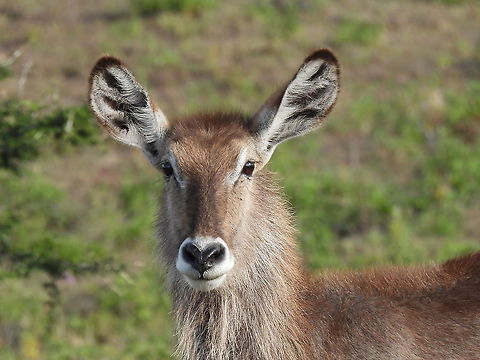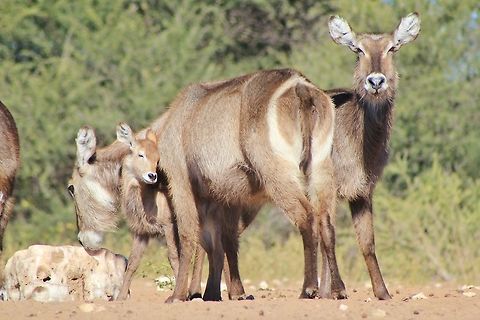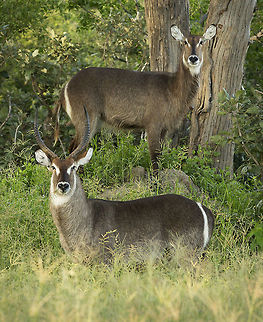
Appearance
Waterbuck stand 120 to 136 cm at the shoulder. Head-and-body length ranges from 140 to 240 cm and tail length from 10 to 45 cm . Males weigh 200–300 kg and females 160–200 kg . Their coats are reddish brown in colour and become progressively darker with age; they have a white 'bib' under their throats and white on their rumps. The waterproofing secretions of the waterbuck's sweat glands produce an unpleasant odor in its meat, unless the animal is skinned carefully. According to African myth, the meat of the waterbuck is not edible, but this is untrue; whilst not especially tasty, waterbuck venison is safe to eat. The long, spiral-structured horns, found only in males, sweep back and up.
Naming
The waterbuck occurs in two main groups, which formerly have been treated as separate species, but they interbreed where their ranges come into contact. The first group is the defassa waterbuck with a white rump patch. It is found west of the Gregory Rift, ranging from Ethiopia west to Senegal and south to Zambia. The second is the ellipsen waterbuck, which has a white, ellipse-shaped ring on the rump that extends above the tail. It is found in southeast Africa, ranging from southern Somalia to KwaZulu-Natal and inland to the Gregory Rift and Botswana. Some authorities accept only these two as valid subspecies, with the trinomial ''K. e. defassa'' for the defassa waterbuck and ''K. e. ellipsiprymnus'' for the ellipsen waterbuck. Others treat the defassa and ellipsen waterbucks as subspecies groups, with as many as 13 separate subspecies in total, among others based on differences in overall colour. In that case, the ellipsen waterbuck includes the first four subspecies in the following list , while the defassa waterbuck includes the remainder:⤷ ''K. e. ellipsiprymnus'' group:
⤷ * ''K. e. ellipsiprymnus'' Ogilby, 1833
⤷ * ''K. e. kondensis'' Matschie, 1911
⤷ * ''K. e. pallidus'' Matschie, 1911
⤷ * ''K. e. thikae'' Matschie, 1910
⤷ ''K. e. defassa'' group:
⤷ * ''K. e. adolfifriderici'' Matschie, 1910.
⤷ * ''K. e. annectens'' Schwarz, 1913
⤷ * ''K. e. crawshayi'' P. L. Sclater, 1894
⤷ * ''K. e. defassa'' Rüppell, 1835
⤷ * ''K. e. harnieri'' Murie, 1867.
⤷ * ''K. e. penricei'' W. Rothschild, 1895
⤷ * ''K. e. tjaederi'' Lönnberg, 1907
⤷ * ''K. e. tschadensis'' Schwarz, 1913
⤷ * ''K. e. unctuosus'' Laurillard, 1842''Kobus'' is from ''koba'', an African name. The species name ''ellipsiprymnus'' refers to the white ring on the rump. ''Ellipes'' from Greek means wanting, defective: an ellipse is a shape deviating from a circle; ''prumnos'' means the hind part.

Habitat
Waterbuck are found in scrub and savanna areas near water, where they eat grasses. Despite their name, waterbuck do not spend much time in the water, but will take refuge there to escape predators. They are diurnal. Females gather in herds of between two and 600 individuals. Males keep territories of around 300 acres during their prime. They usually lose their territories before the age of 10.References:
Some text fragments are auto parsed from Wikipedia.